NVIDIA’s GeForce GT 240: The Card That Doesn't Matter
by Ryan Smith on January 6, 2010 12:00 AM EST- Posted in
- GPUs
Power, Temperature, & Noise
With an idle power draw of 9W, and a load power draw of only 70W, the GT 240 should fare fairly well here. As an added bonus, with the significantly different designs of the Asus and EVGA cards, we have a chance to see the difference in performance for their respective coolers.
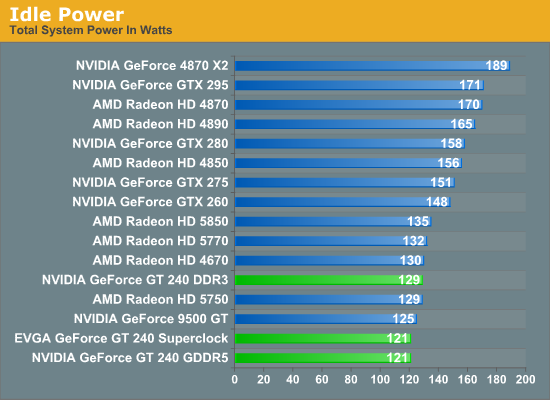
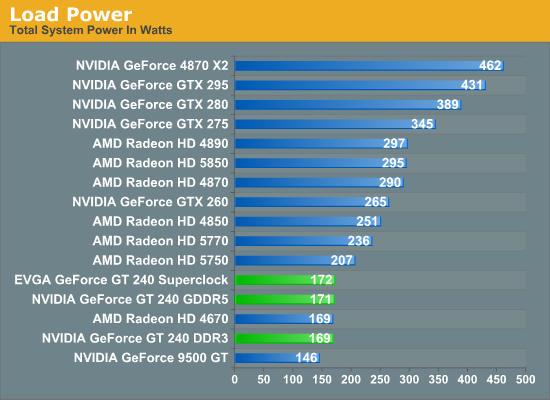
Due to some unrelated issues we don’t have the GT 220 in these charts, leaving the GDDR5 GT 240 as our least power-hungry card when it comes to idling. Unfortunately our DDR3 GT 240 refused to (or is simply not programmed to) idle, meaning that it comes in a good 8W higher than the GDDR5 versions of the cards. The lack of true idling for the DDR3 card will have some ramifications later.
Under load, these cards are still near the top of our charts. The only thing that’s significantly lower is the otherwise anemic 9500 GT while the Radeon 4670 is in a dead-heat. Between the GT 240 cards themselves, even with the different in RAM types, they’re all within 2W of each other. These would probably make fair HTPC cards, but the GT 220 should be a bit less power hungry and cooler.
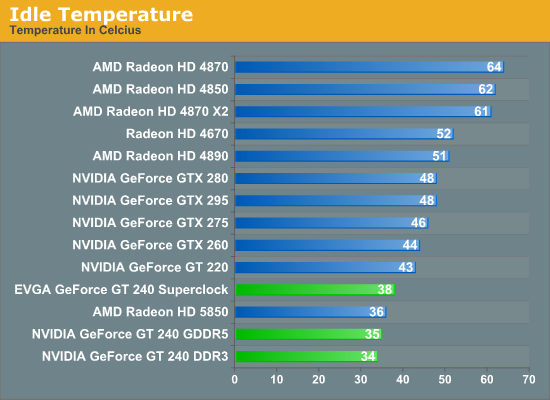
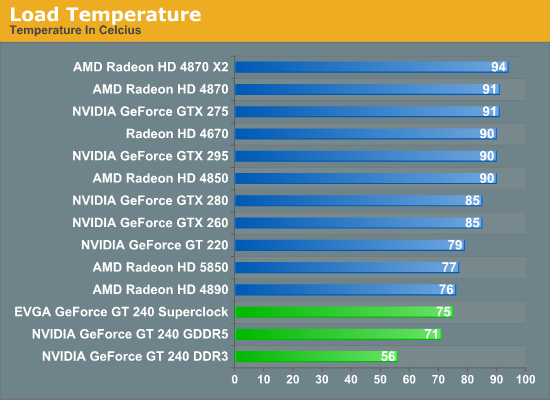
All of these cards push the limits of what’s practical for idle temperatures, although the Radeon 5850 is finally dethroned here by 2 of our GT 240 cards. The double-wide cooler on the Asus cards looks to be good for a couple more degrees than the single-wide cooler on the EVGA card is.
Load temperatures tell us a somewhat different story however. Ignoring the DDR3 card for a second, both the Asus and EVGA cards are quite cool. Our stock Asus card is some 8C cooler than our GT 220, and 19C cooler than the Radeon 4670. The EVGA card meanwhile is 4C cooler than the GT 220, and still 15C cooler than the 4670 in spite of the use of similar single-slot coolers. For what the GT 240 lacks in performance, it can certainly make up for in temperatures.
As for the DDR3 card, in spite of having the same cooler Asus has opted to run the fan at a higher speed. This makes it cooler, but as we’ll see it makes it louder too.
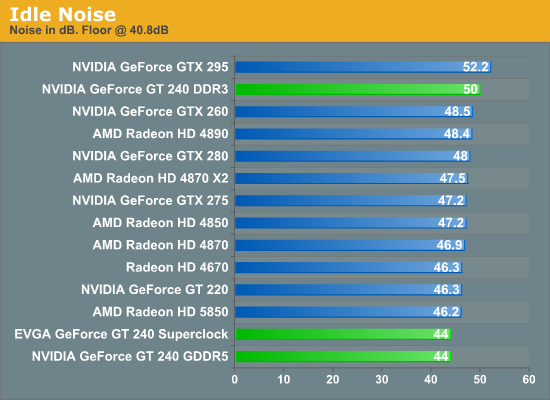
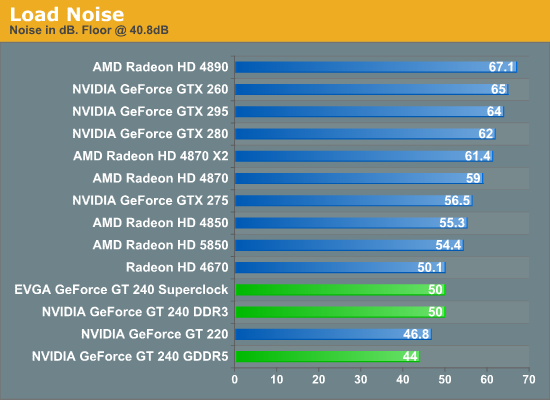
At idle, there’s not much of a story for the GDDR5 cards. They all run up against the ambient noise generated by the rest of the computer. Active and passively cooled cards are nearly indistinguishable at this point. The Asus DDR3 card however is quite distinguishable and is at the bottom of our charts. Its higher fan speeds means that it even idles at a pretty high speed, making it the second-loudest thing after the GTX 295.
It’s under load that the story takes a turn for the most interesting. At 50dB is the Asus DDR3 card and the EVGA card – the former continuing to use its high fan speeds, and the latter having to rev up to make up for its smaller single-slot cooler. Even at 50dB, these cards are quieter than everything besides the otherwise lower-powered GT 220.
Meanwhile down at 44dB is the Asus GDDR5 card, generating the same amount of noise as if it were idling. Based on these results, the card is for all practical purposes indistinguishable from a passively cooled card. Through the combination of a large fan and a large heatsink, the amount of noise the card generates falls below the ambient noise of the rest of the computer. The card is effectively silent.
Now we suspect that if we had a rig specifically for testing silent cards we would find a more notable difference, but in our i7 920 rig there is none to be found. The Asus GT 240 GDDR5 is the quietest actively cooled card we have tested to date, something we were not expecting to find on a GT 240 card. Also bear in mind that this the second-coolest card we have ever tested, falling behind only our overly loud DDR3 card. In the future, someone is probably going to make a very nice fully-passive card out of the GT 240 if all of this can be accomplished with the Asus cooler.










55 Comments
View All Comments
MadMan007 - Wednesday, January 6, 2010 - link
Yup, iyo (in your opinion.) However it's clear from browsing just about any hardware forum for sale section that the used video card market is quite healthy. So if iyo it's a non-starter then you would be free to ignore such comparisons, but it's impossible for others to add such comparisons except by using indirect comparisons.Spoelie - Wednesday, January 6, 2010 - link
"That leaves the 4670, which the GT 240 beats."Except that you compared the GT240 to a 512MB 4670. You can get a 1GB 4670 for $75/$65 before/after rebate, or $70 without rebate.
The extra 512MB would bump up its performance and it still is a lot cheaper than a GT 240.
I can still find several 4770/4850 in stock, for now.
mczak - Wednesday, January 6, 2010 - link
The GT240 DDR3 doesn't beat the HD 4670 512MB if I look at these benchmarks, seems to be about a draw. The HD 4670 is significantly cheaper however. The 1GB HD 4670 are not going to be faster, in fact they are (at settings which are playable at least hence usually not limited by the amount of ram) slightly slower because they use a bit slower ddr3 memory instead of gddr3.The gddr5 version of the GT240 is faster than the HD 4670, I think it will be interesting to see how it'll fare against the HD 5670 (redwood based). If those early leaks are any indication, performance could be close, but I'd suspect the 5670 will draw less power, have more features (DX11, EyeFinity), and not be more expensive.
samspqr - Wednesday, January 6, 2010 - link
I wouldn't say the 240 beats the 4670: it is faster at high quality settings, where fps are unplayable with both cards; at quality settings that mean playable fps, they are kind of even, aren't they?Ryan Smith - Wednesday, January 6, 2010 - link
And just to reply to myself, the 5750 is still suffering from AMD's price inflation. At its MSRP it's worth a look, but at current prices it's in a different price bracket altogether.Zebo - Wednesday, January 6, 2010 - link
How can AMD price 5750 near it's MSRP when two smoke a 5850 and would be cheaper?Zebo - Wednesday, January 6, 2010 - link
MSRP of $109 and beats anything below $150, Thus it's repriced at ~140vol7ron - Wednesday, January 6, 2010 - link
Could you maybe explain why the 9800GT was not covered in the tests, but was talked about a lot on the intro. page?To me that makes no sense. "We'll tell you how the card compares physically, but we won't show you how it compares in practice."
Spacecomber - Wednesday, January 6, 2010 - link
I wondered the same thing. I believe that the 8800GT has the same specifications as the 9800GT; so, it will give you a pretty good idea of how the GT240 stacks up to the 9800GT.Ryan Smith - Wednesday, January 6, 2010 - link
Correct. We list an 8800 GT in our tests because that's the specific card we used, but 8800 GT == 9800 GT in specs and performance.